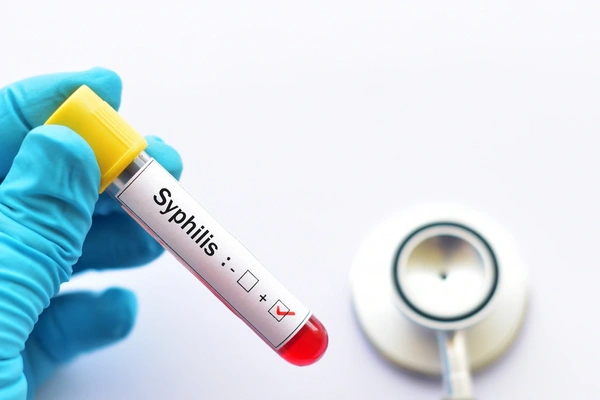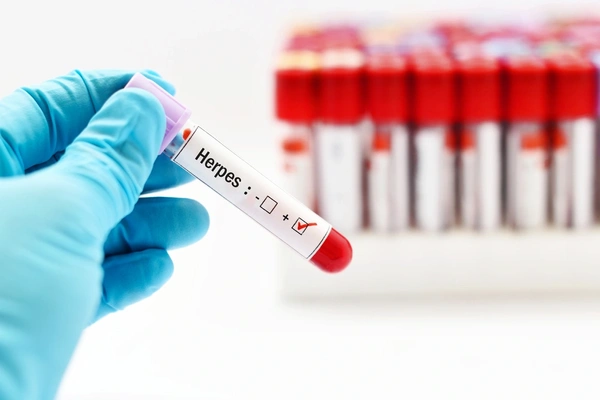- Medically reviewed by Dr Andrea Pinto Lopez, M.D.
An STD (sexually transmitted disease) is an infection that transfers between people through sexual contact,[1] including vaginal intercourse, as well as oral or anal sex. Additionally, although representing a low percentage of transmissions, STDs can also be transmitted in nonsexual ways, such as from mother to infant during pregnancy or childbirth, or through blood transfusions or shared needles.[2]
What are the 10 most common STDs?
- HPV
- Herpes I & II
- Hepatitis B
- Chlamydia
- Syphilis
- Trichomoniasis
- Gonorrhea
- HIV/AIDs
- Mycoplasma genitalium (MG)
- Genital pubic lice (crabs)
Actually, +30 different bacteria can be transmitted through sexual contact, being 8 of these pathogens the ones which are linked to the majority of sexually transmitted diseases. These 8 diseases can be divided between curable (syphilis, gonorrhea, chlamydia and trichomoniasis), and non-curable diseases (hepatitis B, herpes simplex virus (HSV or herpes), HIV, and human papillomavirus (HPV).[3]
Just in the U.S. the CDC reported in 2018, ~1.8M cases of chlamydia, ~580.000 cases of gonorrhea, and ~35.000 cases of syphilis.[4] Remember, if you suspect that you may have one or more of the diseases listed below, it’s highly important that you reduce the risk of spreading the infection further by getting yourself tested. Since many STDs can be completely asymptomatic, it’s also important to get screened for STDs regularly if you’re sexually active, even if you don’t feel any symptoms
Get tested with LetsGetChecked - 30% OFF Home STD Testing with Treatment Included
In this article, we will cover the 8 most prevalent diseases, +2 which besides not being that known are equally important.
Here is a list of 10 most common STDs:
1. Chlamydia
Chlamydia is one of the most commonly reported STDs today, and the most common infection in the U.S. with ~1.8M reported cases in 2018. Chlamydia is transferred via sexual intercourse that includes oral, vaginal and anal sex, even when using condoms during sex.
Long Term Effects: It is caused by an infection with the bacteria Chlamydia Trachomatis, it can origin cervicitis, urethritis, as well as other serious consequences as: ectopic pregnancy, chronic pelvic pain, tubal factor infertility and pelvic inflammatory disease.[5] It is estimated that there are an additional ~1M cases of people having chlamydia and not reporting it to the CDC, as being asymptomatic (no symptoms) and not seeking testing.[6]
Testing and properly treating chlamydia are both very important as the infection can lead to serious health problems. As a consequence, approximately 10 to 15 percent of women with untreated chlamydia will have pelvic inflammatory disease, which can lead to chronic pelvic pain, tubal factor infertility, and potentially fatal ectopic pregnancy. [7]
The CDC recommends “yearly chlamydia screening of all sexually active women younger than 25, as well as older women with risk factors such as new or multiple partners, or a sex partner who has a sexually transmitted infection.”
Do You Have These Symptoms? Pain during intercourse, rectal pain, abnormal discharges (penile or vaginal), swelling in the testicles, throat pain/infection.
Finally, is important to emphasize that, if diagnosed, chlamydia is curable and can be treated with a dose of antibiotics.[8]
Read more about Chlamydia Testing
Get tested for Chlamydia with LetsGetChecked at-home testing kits.
View tests
2. HIV/AIDS
In 2016, the CDC estimated that over 1 million Americans were HIV positive, with nearly 1 in 7 being unaware of their condition [9], (this means 14% of them need testing), making this a highly dangerous and prevalent (common) infection. However, it should be noted that treatment has advanced greatly in recent years, although the disease remains incurable. It is transferred via direct contact between bodily fluids such as semen, vaginal discharge, breast milk and blood.
Long Term Effects: Besides people who is undiagnosed or not receiving proper treatment will eventually become ill over the years and die of complications of the infection, people who is correctly diagnosed and receive proper treatment (ART therapy) will be more prone to live a longer and healthier life, especially if the disease is detected when the immune system is still strong.[10] For this reason is really important detecting HIV in its earlier stages and not leaving the disease to progress to stage 2 or or until the person develops AIDS (stage 3).
Do You Have These Symptoms? If you are experiencing rash, fever, recurring headaches, joint pain, nausea/vomiting, swollen lymph nodes, lesions/sores, fatigue, flu-like illness, it can be a sign of stage 1 of an acute HIV infection, which lasts only 2 to 4 weeks. Please take note that after this stage, stage 2 is a clinical latency period in which people may not have any symptoms or get sick.[11] Stage 2 may last 10 years or more.[12]
Read more about HIV Testing
Get Tested for HIV
3. Gonorrhea
Caused by the bacteria Neisseria Gonorrhoeae, this infection is more widely known as the “clap”. Like chlamydia, it is a common disease (~580.000 reported cases in 2018, U.S.) and can cause similar long-term effects. If diagnosed on an early stage, gonorrhea is unlikely to lead to long term complications, besides, without proper diagnosis and treatment, it can spread to other parts of your body causing serious health problems.[13]
Furthermore, it is also transmitted through vaginal intercourse, oral or anal sex. If properly detected, it can be cured with the proper treatment.[14]
Long Term Effects: May cause PID (pelvic inflammatory disease) in ~10 to ~20% undiagnosed and untreated women, which can result in long term pelvic pain, infertility and pregnancy issues such as ectopic pregnancy. In the case of men gonorrhea can lead to painful infection of the testicles and prostate gland, as well as infertility. Additionally, it can become life-threatening if transferred to other parts of the body, including joints.[15]
Do You Have These Symptoms? Pain when urinating, rectal itching, abnormal discharges, including blood (penile or vaginal), swelling/pain in the testicles, throat pain/infection, abnormal and painful bowel movements.
Read more about Gonorrhea Testing
Get Tested for Gonorrhea
4. HPV (Human Papilloma Virus)
HPV is the most common sexually transmitted infection, with ~79M Americans currently infected, and ~14M people becoming infected every year.[16] There are currently +100 types of HPV, of which at least 14 are high-risk type and can cause cancer. [17] HPV is transmitted via oral, vaginal and anal sex with someone who has the virus, and it can be passed even when the person has no symptoms. HPV can also be transmitted during skin-to-skin contact, even without penetration or genital contact. It remains incurable, although its symptoms can be treated.
Long Term Effects: Untreated, HPV can lead to chronic genital warts and cancer in multiple locations, including the cervix, vagina, vulva, penis and throat.
Do You Have These Symptoms? Lumps/bumps on your genitals, usually accompanied by a genital itching sensation.
Read more about HPV Testing
5. Syphilis
Syphilis is caused by the Treponema Pallidum bacteria, and it is transmitted from person to person via contact with a syphilitic sore, rashes, or fluids (including blood, semen, and vaginal fluid). [18] this STD is becoming more and more common as time progresses mainly as a consequence of increased unsafe sex practices[19]. While Syphilis can be cured, damage from the infection is irreversible, making early detection very important.[20] Syphilis has 4 distinct stages of development, each with different signs and symptoms. It is important to note as well that syphilis can be transferred via vaginal intercourse, as well as through oral or anal sex, with a substantial proportion of cases caused for these reasons.[21] Additionally, syphilis if not detected and treated, can be transmitted from mother to baby during pregnancy and at birth [22] making the simple blood test for syphilis a recommended test as part of prenatal care.
Long Term Effects: As the infection progresses, it may cause paralysis, numbness as well as neurological damage, including dementia, abnormalities in vision and even blindness. Please note that once these symptoms have presented, they cannot be reversed, making early detection highly important.
Do You Have These Symptoms? Firm, round sores that are usually painless, rashes without an itch, lesions in mucous membranes, swelling in lymphatic glands, hair loss (patchy), fatigue, fever and a sore throat
Read more about Syphilis Testing
Get Tested for Syphilis
6. HBV (Hepatitis type B)
Hepatitis type B is a viral infection that attacks the liver and can cause both acute and chronic disease.[23] It is transmitted through direct contact with blood, bodily fluids, infected sores, as well as from an infected mother to child during birth.
Once infected, people usually carry the virus during their whole life, which is called a chronic infection, leading to liver cancer, as individuals with chronic HBV have a ~25% to ~40% lifetime risk of developing liver cancer. [24]
Additionally, HBV can lead in some cases to liver cirrhosis as well [25] In adults, ~5% of infected persons will develop a chronic infection, while in children, up to ~90% develop it before year 1, and up to ~50% develop it before year 6.
If you are pregnant, please take note the importance of being tested of Hepatitis B, as if this is the case, you will need to receive the proper medications in the delivery room to prevent your baby is infected with HBV.[26]
Long Term Effects: If a person has chronic hepatitis, it can develop as well liver cirrhosis and liver cancer.[27]
Do You Have These Symptoms? Fever, yellowing of the skin, abdominal pain, lack of appetite, nausea and vomiting.[28]
Learn more about Hepatitis B Testing
Get Tested for Hepatitis
7. HSV1/2 (Herpes Type 1 and 2) or Genital Herpes
This genital disease is a STD which is caused due to two types of virus, the Herpes simplex type 1 (HSV-1) and Herpes simplex type 2. (HSV-2) [29]
In the case of HSV-1, the virus can be transmitted due to oral-to-oral contact such as kissing, sharing toothbrushes or eating utensils with an infected person.[30] HSV-1 can lead to oral herpes leading to symptoms usually known as “cold sores”, additionally HSV-1 can cause genital herpes as well.[31]
HSV-2 is almost exclusively transferred from an infected person no another due to sexual contact, causing an infection of the genital area or anal area, which is known as genital herpes. For this reason, the only way to avoid this STD is not having vaginal, oral or anal sex or having it inside a long-term monogamous stable relationship as marriage with has been tested negative on genital herpes, in this case, a blood test can determine if the person has herpes infection.[32]
If you are pregnant or have genital herpes, it is extremely important that you go to prenatal care visits and make sure you are not infected with HSV, as the STD can be passed to the child before birth but is most commonly passed during delivery. In such cases, normally a “C-section “will be usually performed.
Long Term Effects: Recent research indicates that HSV may play a role in the development of Alzheimer’s disease, although more research is required. In some rare cases, HSV can cause meningitis or encephalitis. If passed on from mother to child, the infection may develop into a life-threatening condition.
Do You Have These Symptoms? Small blisters, unusual vaginal discharge, pain when urinating.[33] Intermittent sores on the lips, mouth, throat or eyes (HSV1) or on the vulva, vagina, cervix, penis, scrotum and anus (HSV2).[34]
Learn more about Herpes Testing
Get Tested for Herpes
8. Trichomoniasis
This is one of the most common STDs. It is caused by a parasite called Trichomonas vaginalis, in the U.S. alone, ~3.7M people are infected, however, only about ~30% will develop any symptoms.[35] It is passed from an infected person to another - even if symptoms are not visible – thought vaginal intercourse, as well as oral and anal sex. “Trich’’ as it is sometimes called, can be also passed from women to women.[36]
Pregnant women with T. Vaginalis, possess a 30% higher risk of preterm delivery or low weight birth infants.[37] The CDC states that any women with trichomoniasis symptoms should be tested and considered for treatment no matter their pregnancy stage.[38] If properly diagnosed, trichomoniasis can be cured with the right treatment.
Long Term Effects: Untreated, Trichomoniasis can lead to genital inflammation, which will make you more vulnerable to many other infections, most notably HIV.
Do You Have These Symptoms? Women: Yellow or green vaginal discharge, soreness, pain when urinating. Men: Thin, white discharge from the penis, pain when urinating, soreness, redness.[39]
Learn more about Trichomoniasis Testing
Get Tested for Trichomoniasis
9. MG (Mycoplasma Genitalium)
Is a STD most people have never heard of. This bacterium, (Mycoplasma Genitalium) is the smallest known bacteria with the capacity to replicate itself.[40]
This infection has recently emerged as a suggested cause of cervicitis in women[41] and non-gonococcal urethritis in men.
MG is transferred via sexual intercourse that includes oral, vaginal and anal sex. If a person is infected, the suggested treatment is azithromycin or moxifloxicin if the first treatment fails. [43]
Long Term Effects: Like Chlamydia and Gonorrhea, MG can cause PID (pelvic inflammatory disease) in women, which can result in pain, infertility and pregnancy issues.
Do You Have These Symptoms? Burning sensation during urination, spotting and/or bleeding following sexual intercourse (between periods), a fishy odor and/or abnormal vaginal discharge (women), discharges from the urethra, burning sensation when urinating (men).[44]
10. Genital (Pubic) Lice/Crabs
This highly common STD infects around 3 million people in the U.S. every year through sexual contact.[45] The lice are usually spread thought vaginal intercourse, as well as oral or anal sex. Other types of bodily contact such as kissing, or hugging can also spread the disease. Finally, it is possible that the lice are spread as a consequence of sharing clothes, towels or bedding, but this is rarely the case.[46]
These lice-like creatures live between the pubic hairs but can be removed with the help of special shampoo sold over the counter, as well as insecticide creams or lotions. Please consult your physician or pharmacist.
Long Term Effects: Itching and discomfort.
Do You Have These Symptoms? Itching, small bugs and eggs between pubic hairs, dark spots where bitten by the bugs, feeling of fatigue.
Finally, it is important to note that the only 100% guaranteed methods of preventing any STD or STI are either not having any kind of sexual contact or having it inside a monogamous relationship with a non-infected person. In case you are outside one of these two groups, please consider you are at risk of developing an STD or STI, in this case, or if you experience any symptoms, a visit to your doctor and receiving an STD test can be the first steps to take.
Get tested with LetsGetChecked - 30% OFF Home STD Testing with Treatment Included
FAQ
Resources
- Sexually Transmitted Diseases - medlineplus.gov
- Sexually transmitted diseases (STDs) - mayoclinic.org
- Sexually transmitted infections (STIs) - who.int (World Health Organization)
- Sexually Transmitted Disease Surveillance 2018 - cdc.gov
- Chlamydia - CDC Fact Sheet (Detailed) - cdc.gov
- 6.Sexually Transmitted Infections Among US Women and Men - journals.lww.com
- Chlamydia - CDC Fact Sheet (Detailed) - cdc.gov
- Chlamydia - CDC Fact Sheet - cdc.gov
- U.S. Statistics - hiv.gov
- Is HIV always fatal? - hiv.va.gov
- Stages of HIV Infection - cdc.gov
- SYMPTOMS AND STAGES OF HIV INFECTION - https://www.avert.org
- Gonorrhoea - Complications - https://www.nhs.uk
- Gonorrhea Treatment and Care - cdc.gov
- Gonorrhoea - mayoclinic.org
- Genital HPV Infection - Fact Sheet - cdc.gov
- Human papillomavirus (HPV) and cervical cancer - https://www.who.int/ (World Health Organization)
- Syphilis - niaid.nih.gov
- New CDC Report: STDs Continue to Rise in the U.S. - cdc.gov
- Syphilis Treatment and Care - cdc.gov
- Misconception: Oral Sex Can’t Spread Syphilis - webmd.com
- Syphilis - betterhealth.vic.gov.au
- Hepatitis B - who.int (World Health Organization)
- Hepatitis B Risk Factors - hepb.org
- Facts About Hepatitis B for Adults - nfid.org
- Pregnancy and Hepatitis B - hepb.org
- Hepatitis - homehealth-uk.com
- Hepatitis B - mayoclinic.org
- Genital Herpes - CDC Fact Sheet - cdc.gov
- Herpes Simplex Virus: HSV-1 & HSV-2 - webmd.com
- Herpes simplex virus - https://www.who.int/ (World Health Organization)
- Genital Herpes - CDC Fact Sheet - cdc.gov
- Genital herpes - www.nhs.uk
- HERPES SIMPLEX: SIGNS AND SYMPTOMS - aad.org
- Trichomoniasis - CDC Fact Sheet - cdc.gov
- Trichomoniasis - womenshealth.gov
- Trichomonas vaginalis - nih.gov
- Trichomoniasis - cdc.gov
- TRICHOMONIASIS SYMPTOMS & TREATMENT - avert.org
- New guidelines issued on the ‘STI most people have never heard of’ - nhs.uk
- Mycoplasma genitalium Infection - jcm.asm.org
- Mycoplasma genitalium Infection in Men - nih.gov
- Mycoplasma genitalium: Should We Treat and How? - nih.gov 44.Mycoplasma genitalium infection - including symptoms, treatment and prevention - sahealth.sa.gov.au
- Crabs - dph.illinois.gov
- Pubic lice - nhs.uk



